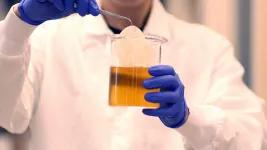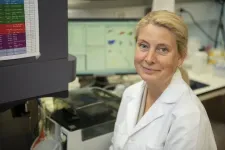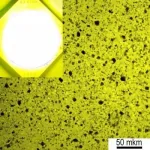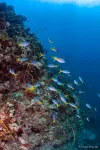Metamaterial tiles boost sensitivity of large telescopes
Low-cost, mass producible technology poised to help Simons Observatory yield new insights into how the universe began
2021-01-26
(Press-News.org) WASHINGTON -- A multi-institutional group of researchers has developed new metamaterial tiles that will help improve the sensitivity of telescopes being built at the preeminent Simons Observatory in Chile. The tiles have been incorporated into receivers that will be deployed at the observatory by 2022.
The Simons Observatory is the center of an ambitious effort to measure the cosmic microwave background -- electromagnetic radiation left over from an early stage of the universe -- using some of the world's largest and most sophisticated ground-based telescopes. These measurements will help improve our understanding of how the universe began, what it is made of and how it evolved into what it is today.
"The Simons Observatory telescopes will use a new ultra-sensitive millimeter-wave camera to measure the afterglow of the big bang with unprecedented sensitivity," said lead author Zhilei Xu from the University of Pennsylvania. "We developed a new low-cost absorbing tile that will be used in the camera to absorb environmental emissions that can obscure the signals we want to measure."
In the Optical Society (OSA) journal Applied Optics, the researchers show that the metamaterial microwave tiles they developed absorb more than 99 percent of millimeter wave radiation and retain their absorptive properties at the extremely low temperatures in which the millimeter-wave camera operates.
"Because the tiles can be made by injection molding commercially available materials, they are an economic, mass-producible and easy-to-install solution to what has been a long-standing problem," said Xu. "With this technology, the Simons Observatory will transform our understanding of the universe from many aspects, including the beginning of the universe, the formation and evolution of the galaxies and the ignition of the first stars."
Working at low temperatures
Ground-based millimeter-wave telescopes use receivers that are cooled to cryogenic temperatures to reduce noise and thus boost sensitivity. Receiver technology has advanced to the point where any amount of stray light can degrade the image while also decreasing the sensitivity of the detector. A better way to suppress stray light within the receivers would further increase their sensitivity to the very faint signals coming from deep within space.
However, developing a material that can suppress stray light while operating at such extremely low temperatures is quite challenging. Previous attempts resulted in materials that either couldn't be cooled effectively to cryogenic temperatures or didn't achieve the necessary combination of low reflectance and high absorption. Other solutions have also tended to be difficult to install or challenging to mass produce.
To overcome these challenges, the researchers turned to metamaterials because they can be engineered to achieve specific properties that don't occur in nature. After complex electromagnetic simulation studies, the researchers designed metamaterials based on a material that combined carbon particles and plastic.
Reducing reflection
Although the plastic composite exhibited high absorption in the desired microwave region of the electromagnetic spectrum, the surface reflected a significant amount of radiation before it could get inside the material to be absorbed. To reduce the reflection, the researchers added an anti-reflective coating that was tailored using injection molding.
"The low-reflectance surface combined with high-absorption bulk material allowed the metamaterial absorber tiles to deliver excellent suppression of unwanted signals at cryogenic temperatures close to absolute zero," said Xu.
After ensuring that tiles made of the new metamaterial could mechanically survive thermal cycles from room temperatures to cryogenic temperatures, the researchers verified that they could be effectively cooled to -272° C (-458° F) and then measured their optical performance. "We developed a custom test facility to measure the performance of the tiles with high fidelity," said Grace Chesmore, a graduate student at the University of Chicago who led the optical measurements of this research. The testing showed that the metamaterial exhibited excellent reflectance properties with low scattering and that it absorbed almost all of the incoming photons.
"As detector sensitivity continues to improve for millimeter-wave telescopes, it becomes crucial to control scattered photons," said Xu. "The successful combination of a metamaterial and injection molding manufacturing opens up many possibilities for millimeter-wave instrument scientific instrument design."
INFORMATION:
The work was a result of a large global collaboration that included researchers from the University of Pennsylvania, the University of Chicago, Goddard Space Flight Center, Massachusetts Institute of Technology and other institutions.
Paper: Z. Xu, G. E. Chesmore, S. Adachi, A. M. Ali, A. Bazarko, G. Coppi, M. Devlin, T. Devlin, S. R. Dicker, P. A. Gallardo, J. E. Golec, J. E. Gudmundsson, K. Harrington, M. Hattori, A. Kofman, K. Kiuchi, A. Kusaka, M. Limon, F. Matsuda, J. McMahon, F. Nati, M. D. Niemack, A. Suzuki, G. P. Teply, R. J. Thornton, E. J. Wollack, M. Zannoni, N. Zhu, "The Simons Observatory: Metamaterial Microwave Absorber (MMA) and its Cryogenic Applications," Applied Optics, 60, 4, 864-874 (2021).
DOI: https://doi.org/10.1364/AO.411711
ELSE PRESS RELEASES FROM THIS DATE:
2021-01-26
Providing economic relief to struggling families can lead to another positive effect -- fewer cases of child neglect, according to new research by the University of Washington.
A 10% increase in a common benefit for low- to moderate-income working families, the Earned Income Tax Credit, led to a 9% decrease in the annual number of reports of child neglect made to child welfare agencies over a 14-year study period. That's a significant impact, researchers say, and can inform future social policies.
The study is relevant to current policy actions, as President Joe Biden has recently proposed an expansion ...
2021-01-26
RESEARCH TRIANGLE PARK, N.C. -- Kombucha tea, a trendy fermented beverage, inspired researchers to develop a new way to generate tough, functional materials using a mixture of bacteria and yeast similar to the kombucha mother used to ferment tea.
With Army funding, using this mixture, also called a SCOBY, or symbiotic culture of bacteria and yeast, engineers at MIT and Imperial College London produced cellulose embedded with enzymes that can perform a variety of functions, such as sensing environmental pollutants and self-healing materials.
The team also showed that they could incorporate yeast directly into the cellulose, creating living materials that could be used to purify water for Soldiers in the field or make smart packaging materials that can detect damage.
"This ...
2021-01-26
COLUMBIA, Mo. - In 2016, the World Health Organization called the Zika virus epidemic a "public health emergency of international concern" due to the virus causing birth defects for pregnant women in addition to neurological problems. Since then, researchers have wrestled with different strategies for controlling the spread of Zika virus, which gets transmitted to humans from female mosquito bites.
One approach, which was approved by the Environmental Protection Agency in May, will release more than 750 million genetically modified mosquitos into the Florida Keys in 2021 and 2022. These "suicide mosquitos" are genetically-altered to produce offspring that die before emerging into adults and therefore cannot ...
2021-01-26
An international research collaboration, involving scientists from the UK, US and Spain, has shed new light on the usefulness of digital contact tracing (DCT) to control the spread of Covid-19.
The study, published today in Nature Communications, assessed the effectiveness of the Spanish DCT app, Radar COVID, following a 4-week experiment conducted in the Canary Islands, Spain between June-July 2020.
For the experiment, funded by the Secretary of State of Digitalisation and Artificial Intelligence (SEDIA), the researchers simulated a series of Covid infections in the capital of La Gomera, San Sebastián de la Gomera, to understand whether the Radar COVID app technology could ...
2021-01-26
Individual variations in how the immune system responds to SARS-CoV-2 appear to impact the severity of disease. Researchers at Karolinska Institutet in Sweden have now been able to show that patients with severe COVID-19 have significantly elevated levels of a certain type of immune cells in their blood, called myeloid-derived suppressor cells. The study published in the Journal of Clinical Investigation may bring an increased understanding of how early immune responses impact disease severity.
Most individuals with COVID-19 develop mild to moderate symptoms and recover without needing hospital treatment. In severe cases, however, COVID-19 can lead to respiratory failure or even death. It is not yet known ...
2021-01-26
Materials scientists of Far Eastern Federal University (FEFU), in collaboration with an international research team, have advanced the design of composite ceramic materials (Ce3+:YAG-Al2O3), i.e. solid-state light converters (phosphors) that can be applied in-ground and aerospace technologies. The LED systems based on the developed materials to save 20-30 percent more energy compared to commercial analogues. A related article was published in Materials Characterization.
Over 15% of the total global electricity production or about $ 450 billion annually spent on lighting. According to the photonics development roadmap run in Russia, the development of LED technology with an efficiency of more than 150 ...
2021-01-26
Canada could be sitting on a significant untapped resource, as the number of PhD holders in this country rises, but persistent barriers make it hard for them to put their skills to work. According to a new expert panel report from the Council of Canadian Academies (CCA), PhD graduates play a critical role in the Canadian economy, but many are missing out on important opportunities to contribute their expertise and bolster growth and innovation.
"The growing number of PhD graduates in Canada could represent a significant opportunity to drive innovation and increase our competitiveness in a global economy," said M. Elizabeth Cannon, O.C., PhD, FRSC, FCAE, Chair of the Expert Panel. "The difficulties graduates face raise important questions about the nature of PhD ...
2021-01-26
"74 percent of the respondents consider the national vaccination strategy to be appropriate," says BfR-President Professor Dr. Dr. Andreas Hensel. "This indicates that the strategy is accepted."
While some regulations, such as the cancellation of events or the quarantine measures, have always been met with approval in recent months, other measures are now less accepted. Whereas shortly before Christmas, 84 percent of the respondents considered the contact restrictions to be appropriate, 74 percent say so in the current survey. Over the same period, approval of the closure of shops fell by ten percentage points to 56 percent.
In the previous ...
2021-01-26
BROOKLYN, New York, Monday, January 26, 2021 - Atomically thin, 2D hexagonal boron nitride (h-BN) is a promising material whose protean ability to undergo phase transformations to strong, super lightweight, chemically stable, oxidation-resistant films makes them ideal for protective coatings, nanotechnology thermal applications, deep-UV light emitters, and much more.
The possibilities embodied in different polytypes of h-BN include the ultra-hard diamond phase, a cubic structure (c-BN) with strength and hardness second only to actual carbon diamonds. Key to fabricating such materials is the ability to induce and control the transformation between their various crystalline phases, in a way that is efficient and cost effective enough to allow for economies of scale.
While ...
2021-01-26
An international group of scientists is predicting markedly different outcomes for different species of coral reef fishes under climate change - and have made substantial progress on picking the 'winners and losers'.
Associate Professor Jodie Rummer from James Cook University's ARC Centre of Excellence for Coral Reef Studies co-authored a study that exposed two species of coral reef fishes to elevated temperatures and measured their responses over time.
"We collected five-lined cardinalfish and redbelly yellowtail fusilier from the Great Barrier Reef, and under controlled conditions in the laboratory at JCU, slowly raised the temperature ...
LAST 30 PRESS RELEASES:
[Press-News.org] Metamaterial tiles boost sensitivity of large telescopes
Low-cost, mass producible technology poised to help Simons Observatory yield new insights into how the universe began





